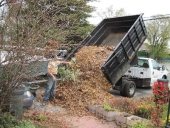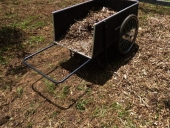





-Manda
I am not at all related to Paul Wheaton, the amazingness of this great forum! We just share a great name! Currently here working through life, as a middle age widow, who balances work, school, chlidren while trying to build her empire of a beautiful permaculture friendly homestead in Michigan in my "spare" time.




Patience with my ignorance is required as this new to Growies old lady tries to build a food forest in the arid high desert. Thank you for all the advice. 
 1
1




 1
1




 Stupid simple and you can buy the parts at any big box store. Pay for themselves in the water they save.
Stupid simple and you can buy the parts at any big box store. Pay for themselves in the water they save."You must be the change you want to see in the world." "First they ignore you, then they laugh at you, then they fight you, then you win." --Mahatma Gandhi
"Preach the Gospel always, and if necessary, use words." --Francis of Assisi.
"Family farms work when the whole family works the farm." -- Adam Klaus

 1
1






 1
1




Amanda Wheaton wrote:say this is your land and these are your newly planted fruit trees.
...
If these were your trees with same sandy ground, what would you do to maximize their moisture retention so that you didn't spend every 3rd day out there in the middle of summer with 5 gallon buckets in your hands?
Works at a residential alternative high school in the Himalayas SECMOL.org . "Back home" is Cape Cod, E Coast USA.




 but yes I have a kitty and I will try that..and mulching. Most of my trees were planted this year and within the last 2 years so still needing to water and water frequently. Specially since I tore the cherries apart and replanted them. I guess what i will do is mulch mulch mulch (and i knew i would have to lol) and just keep watering them via buckets heavily for this year and maybe next. By then I think they should be established enough with the mulch that I can back off and by then perhaps there will be enough rain to keep them well fed. My fertilizer has been cow manure. Since it leaches away so fast I can use it fresh and it wouldn't burn but then i also wasn't using as MUCH as i am apparently supposed to. I have two things to fix soon as the snow is gone... more mulch and heavier fertilizer (which by now is composted)
but yes I have a kitty and I will try that..and mulching. Most of my trees were planted this year and within the last 2 years so still needing to water and water frequently. Specially since I tore the cherries apart and replanted them. I guess what i will do is mulch mulch mulch (and i knew i would have to lol) and just keep watering them via buckets heavily for this year and maybe next. By then I think they should be established enough with the mulch that I can back off and by then perhaps there will be enough rain to keep them well fed. My fertilizer has been cow manure. Since it leaches away so fast I can use it fresh and it wouldn't burn but then i also wasn't using as MUCH as i am apparently supposed to. I have two things to fix soon as the snow is gone... more mulch and heavier fertilizer (which by now is composted)-Manda
I am not at all related to Paul Wheaton, the amazingness of this great forum! We just share a great name! Currently here working through life, as a middle age widow, who balances work, school, chlidren while trying to build her empire of a beautiful permaculture friendly homestead in Michigan in my "spare" time.





 1
1




Works at a residential alternative high school in the Himalayas SECMOL.org . "Back home" is Cape Cod, E Coast USA.




Rebecca Norman wrote:Newly transplanted trees don't want large amounts of "fertilizer" (ie nitrogen) in the first year or two. It stressed them out by forcing them to produce lots of leaves when they don't yet have strong roots. What they, and most plants, appreciate is plenty of humus (well rotted compost and leaf mold) to help hold and modulate water and nutrients. Animal dung is high in nitrogen, so don't give a lot this year -- give lots of mulch to shade the soil to conserve moisture and harbor worms etc, and maybe next year add some manure, as well as more mulch.
When you said you "couldn't mulch because you need to get the moisture down in there" it doesn't make much sense to me. If you were using a sprinkler to deliver water, that would be a problem. You shouldn't use a sprinkler to water your young trees: you should pour water from a bucket or a hose into a saucer-shaped depression with a soil rim, that you make around each new tree. The water will go under the mulch and make it float while the water soaks down, moistening the bottom layer of mulch, which is a good thing. Anyway, I don't think you're using a sprinkler since you mention the hardship of lugging buckets.
-Manda
I am not at all related to Paul Wheaton, the amazingness of this great forum! We just share a great name! Currently here working through life, as a middle age widow, who balances work, school, chlidren while trying to build her empire of a beautiful permaculture friendly homestead in Michigan in my "spare" time.




-Manda
I am not at all related to Paul Wheaton, the amazingness of this great forum! We just share a great name! Currently here working through life, as a middle age widow, who balances work, school, chlidren while trying to build her empire of a beautiful permaculture friendly homestead in Michigan in my "spare" time.









Works at a residential alternative high school in the Himalayas SECMOL.org . "Back home" is Cape Cod, E Coast USA.















|
Lookout! Runaway whale! Hide behind this tiny ad:
The new gardening playing cards kickstarter is now live!
https://www.kickstarter.com/projects/paulwheaton/garden-cards
|






